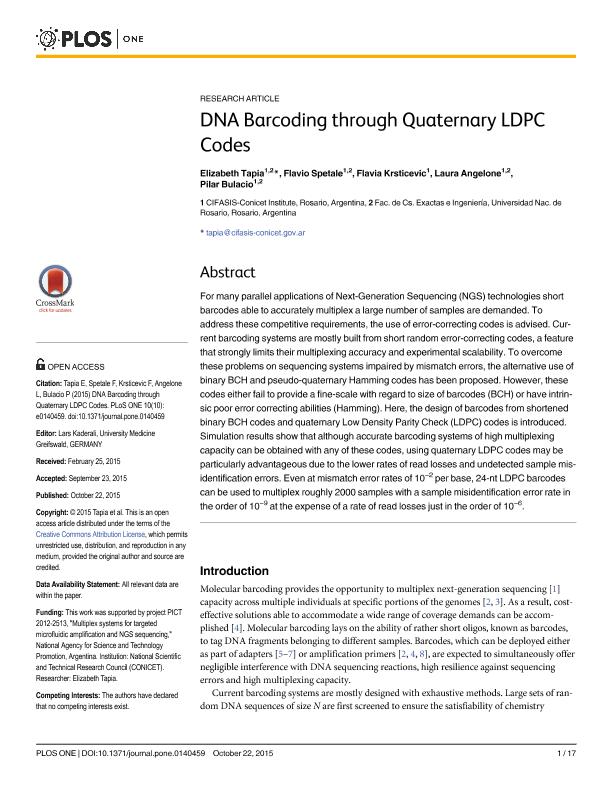Artículo
DNA barcoding through quaternary LDPC codes
Tapia Paredes, Elizabeth; Spetale, Flavio Ezequiel ; Krsticevic, Flavia Jorgelina
; Krsticevic, Flavia Jorgelina ; Angelone, Laura Monica; Bulacio, Pilar Estela
; Angelone, Laura Monica; Bulacio, Pilar Estela
 ; Krsticevic, Flavia Jorgelina
; Krsticevic, Flavia Jorgelina ; Angelone, Laura Monica; Bulacio, Pilar Estela
; Angelone, Laura Monica; Bulacio, Pilar Estela
Fecha de publicación:
10/2015
Editorial:
Public Library of Science
Revista:
Plos One
ISSN:
1932-6203
Idioma:
Inglés
Tipo de recurso:
Artículo publicado
Clasificación temática:
Resumen
For many parallel applications of Next-Generation Sequencing (NGS) technologies short barcodes able to accurately multiplex a large number of samples are demanded. To address these competitive requirements, the use of error-correcting codes is advised. Current barcoding systems are mostly built from short random error-correcting codes, a feature that strongly limits their multiplexing accuracy and experimental scalability. To overcome these problems on sequencing systems impaired by mismatch errors, the alternative use of binary BCH and pseudo-quaternary Hamming codes has been proposed. However, these codes either fail to provide a fine-scale with regard to size of barcodes (BCH) or have intrinsic poor error correcting abilities (Hamming). Here, the design of barcodes from shortened binary BCH codes and quaternary Low Density Parity Check (LDPC) codes is introduced. Simulation results show that although accurate barcoding systems of high multiplexing capacity can be obtained with any of these codes, using quaternary LDPC codes may be particularly advantageous due to the lower rates of read losses and undetected sample misidentification errors. Even at mismatch error rates of 10-2 per base, 24-nt LDPC barcodes can be used to multiplex roughly 2000 samples with a sample misidentification error rate in the order of 10-9 at the expense of a rate of read losses just in the order of 10-6.
Palabras clave:
LDPC
,
MULTIPLEX NGS
,
DNA
Archivos asociados
Licencia
Identificadores
Colecciones
Articulos(CIFASIS)
Articulos de CENTRO INT.FRANCO ARG.D/CS D/L/INF.Y SISTEM.
Articulos de CENTRO INT.FRANCO ARG.D/CS D/L/INF.Y SISTEM.
Citación
Tapia Paredes, Elizabeth; Spetale, Flavio Ezequiel; Krsticevic, Flavia Jorgelina; Angelone, Laura Monica; Bulacio, Pilar Estela; DNA barcoding through quaternary LDPC codes; Public Library of Science; Plos One; 10; 10; 10-2015; 1-17
Compartir
Altmétricas



